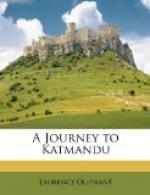guarded the lower steps as efficiently as he did the
upper ones. There were at least four pagodas,
painted in like way, and guarded in like manner, in
the great square of Katmandu. The guard-house
contained a large stand of arms of antique construction.
There was also the Durbar, the residence of the Rajah,
a straggling building, almost European in its style,
and gaudy enough to please even the late King of Bavaria;
close to it was a huge deformed image of Siva, sitting
in an uncomfortable posture on a square stone, violently
gesticulating with her fourteen arms, perhaps at a
party of heretical Bhootyas who were passing tranquilly
by, leading along their sheep, decidedly the cleanest
and most respectable-looking members of the group.
Beyond, high and gloomy houses almost touched, their
wooden fringes creaking responsively to one another
across the narrow streets, while the owners of the
cobwebby tenements, peeping out of the narrow windows
in their balconies, made their remarks upon the strangers
in not much more melodious tones; in an old court-yard
a little way above, was visible an unwieldy rhinoceros,
placidly contemplating a bundle of grass, from which
it had satisfied its hunger, in happy ignorance that
its life is dependent on that of the Rajah; for in
Nepaul it is a rule that the death of one great animal
should be immediately followed by that of another,
and, when a Rajah dies, a rhinoceros is forthwith
killed to keep him company. As he stood tethered
almost under the palace windows, we thought him at
once a fitting moral and a characteristic background
to this novel and interesting picture.
CHAPTER VIII.
The temple of Sumboonath—View from the
platform of the temple—The valley of Nepaul
and its resources—Tradition respecting it—Entrance
of the Prime Minister into Katmandu—The
two kings—A brilliant reception.
The temple of Sumboonath, which we next visited, is
situated on the summit of a woody eminence; it is
approached by a long flight of steps, the trouble
of ascending which is amply compensated by the lovely
view which the platform of the temple commands, as
well as by an inspection of the curious construction
of the building itself.
Sumboonath is looked upon as one of the oldest temples
in Nepaul, and was erected, according to Kirkpatrick,
when Nepaul was ruled by a race of Thibetians; its
possession was at one time claimed by the Dalai Lama,
or Sovereign Pontiff of H’Lassa, but he has
since been obliged to abandon the claim.
The Dagoba resembles the temple of Bhood, but is only
about half its size; the spire is covered with plates
of copper, gilt. It is surrounded by pagodas,
as well as numerous more modern shrines of a bastard
Hindoo class, to which Bhootyas and Bhamas, a tribe
of Newars, resort in great numbers. Occasionally
the Ghorkas visit these shrines; the thunderbolt of
Indra, which is here exhibited, being, I suppose, the
object of attraction to them, as they pride themselves
on being orthodox Hindoos.




